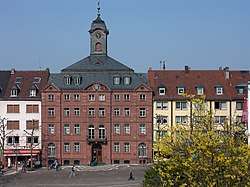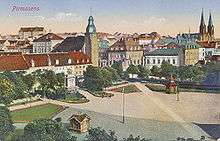Pirmasens
| Pirmasens | ||
|---|---|---|
 Old town hall | ||
| ||
 Pirmasens | ||
| Coordinates: 49°12′N 7°36′E / 49.200°N 7.600°ECoordinates: 49°12′N 7°36′E / 49.200°N 7.600°E | ||
| Country | Germany | |
| State | Rhineland-Palatinate | |
| District | Urban district | |
| Government | ||
| • Lord Mayor | Bernhard Matheis (CDU) | |
| Area | ||
| • Total | 61.37 km2 (23.70 sq mi) | |
| Elevation | 380 m (1,250 ft) | |
| Population (2017-12-31)[1] | ||
| • Total | 40,632 | |
| • Density | 660/km2 (1,700/sq mi) | |
| Time zone | CET/CEST (UTC+1/+2) | |
| Postal codes | 66953–66955 | |
| Dialling codes | 06331 | |
| Vehicle registration | PS | |
| Website | www.pirmasens.de | |
Pirmasens is an independent town in Rhineland-Palatinate, Germany, near the border with France. It was famous for the manufacture of shoes. The surrounding rural district was called Landkreis Pirmasens from 1818 until 1997, when it was renamed to Südwestpfalz.
Pirmasens can be easily mistaken with Primasens, of which means a first sense in Latin-derived languages.
History
Early years
The first mention of "Pirminiseusna", a colony of Hornbach Abbey, dates from 860. The name derives from St. Pirminius, the founder of the cloister. During the period it was under rule of the Bishopric of Metz.[2] Homepage of the Protestant church communities and Brenschelbach Hornbach: The history of the monastery of Hornbach</ref> It was passed to Diocese of Speyer in last quarter of 11th century before capturing by County of Saarbrücken in 1100.
In 1182, County of Saarbrücken was divided by Simon II and Henry I, were sons of Simon I. Pirmasens was given to latter and Henry I's dominion was named as County of Zweibrücken.[3] He built Lemberg Castle for protecting his dominion in 1198. During the period Pirmasens was formal jurisdiction in Bishop of Metz. But, parish administration of Pirmasens was passed to monastery of Hornbach after confirmation of John, Bishop of Metz in 1225.
In 1297, County of Zweibrücken was divided and Pirmasens was passed to County of Zweibrücken-Bitsch, Eberhard I's dominion. He traded some localities with Duke Frederick III of Lorraine and took lordship of Bitsch at same year. In this period village of Pirmasens was part of Reischsamt of Lemberg.
In 1525, during German Peasants' War, Pirmasens was looted by peasants of Bitsch.
In 1560, Ludowika Margaretha of Zweibrücken-Bitsch, was daughter of Count James of Zweibrücken-Bitsch (1510–1570), was the last male member of the House of Zweibrücken, was married of Philip V, Count of Hanau-Lichtenberg. In 1570, County of James of Zweibrücken-Bitsch died without male heir and Countess Ludowika Margaretha inherited the County of Bitsch, the Lordship of Ochsenstein and half the Lordship of Lichtenberg (his father already held the other half). James's older brother, Simon V Wecker, had already died in 1540, also without a male heir. A dispute about the inheritance erupted between the husbands of Ludowika Margaretha and her cousin Amalie, Philip V of Hanau-Lichtenberg and Philip I of Leiningen-Westerburg,[4] respectively. Formally, the County of Bitsch and district of Lemberg were fiefs of the Duchy of Lorraine and such fiefs could only be inherited in the male line.
Philip V was initially successful in the dispute with Philip I about Zweibrücken-Bitsch. However, he introduced the Lutheran confession in his newly gained territories in 1572. This made the powerful and Catholic Duke of Lorraine unhappy. The Duke terminated the fief and in July 1572 Lorraine troops occupied the county. Since Philip V's army was no match for Lorraine, he took his case to the Imperial Chamber Court in Speyer. During the trial, Lorraine argued that, firstly, a significant part of the territory of Zweibrücken-Bitsch had been obtained in an exchange with Lorraine in 1302 and, secondly, the Counts of Leiningen had sold their hereditary claims to Lorraine in 1573. In 1604, Hanau-Lichtenberg and Lorraine decided to settle out of court. In a treaty signed in 1606, it was agreed that Bitsch would revert to Lorraine and Hanau-Lichtenberg would retain Lemberg. This was reasonable, as it corresponded approximately to the religious realities of the territories. Thus, Pirmasens was part of County of Hanau-Lichtenberg.
Before the Thirty Years War, Pirmasens had 59 families and about 235 inhabitants resident, whereas in Lemberg were counted 54 families (about 215 people). When counting is assumed that at that time there was a family of four to five people. In 1622, Pirmasens and Lemberg were ravaged by Spaniards and Croatian horsemen of the Imperial troops. The imperial army set fire to the village. Even the church was destroyed in a fire, after the withdrawal of the troops, Pirmasenser began to rebuild it.[5] It was again ravaged by imperial troops under Matthias Gallas. They also looted Lemberg Castle, which was burned in 1636. Then the headquarters of the Lutheran parish of Lemberg was moved to Pirmasens.[6] But, it was heavily damaged in it. In 1657, only 9 families (about 40 people) were lived in it. However, the population increased by immigration Reformed Swiss, Catholic Tyrolean and families from Franconia and Württemberg slowly, so that in 1661 in Pirmasens 21 families (about 87 people) were counted. However, during Franco-Dutch War, Louis XIV sent troops to the Palatinate under his marshall Turenne for relieve fortress of Landau and reinforce imperial ones. In 1677 Pirmasens was occupied and burned. It was under French rule until 1679. In 1691, only 16 people were lived in village of Pirmasens. During the Nine Years' War, it was sacked by French troops under General de Ezéchiel Mélac, who devastated the Palatinate in 1689. At same time the Lemberg Castle was still habitable after the destruction of the Thirty Years' War, completely destroyed. Thus, administrative centre of Reichsamt Lemberg was moved to Pirmasens in 1697. So, Pirmasens elevated to town status.
In 1736, Johann Reinhard III, who last count of Hanau-Lichtenberg, died without male heir and the duchy was passed to Landgrave Ludwig IX of Hesse-Darmstadt, who was son of Countess Charlotte of Hanau-Lichtenberg, sole heir of County of Hanau Lichtenberg and Ludwig VIII, Landgrave of Hesse-Darmstadt.
In 1763 Pirmasens is chartered by landgrave Ludwig IX (Hesse-Darmstadt).
In 1793 it was the location of the Battle of Pirmasens between Prussia and Braunschweig against the French Corps of the Vosges. The French lost the battle, but their opponents' divisions nevertheless enabled them to return and occupy Pirmasens by the end of the year: between 1798 and 1814, the town was included in the French département of Mont-Tonnerre ("Donnersberg-Département" in German). After the French defeat, it was bounded to Rhenish Palatinate of Bavaria.
20th century

- 1923/24 tests of Palatinate separatists to settle down in Pirmasens failed on 12 February 1924: occupation of the district town hall, home of the separatist administration; many deaths on both sides
- 9 November 1938 destruction of the synagogue during the Kristallnacht.
On 15 March 1945 Pirmasens was captured by US troops, and the following year it became part of the newly founded Bundesland Rhineland-Palatinate. During the occupation on Sept. 19 the Museum of Pirmasens announced that about 50 paintings which had been stored in the air-raid shelter at Husterhoh School during the war have been plundered during the arrival of the American troops. The paintings were returned in 2006. [7]
Main sights

- Dynamikum, a science museum
- Old Postal Building, with an exhibition of the life and work of Hugo Ball and a picture gallery of the painter Heinrich Bürkel
- Collected works of Hugo Ball in the public library
- Old Town Hall, now a museum of local history and shoes, with silhouettes from Elisabeth Emmler
- Siegfried Line Museum
Incorporations
- 1969: Erlenbrunn, Fehrbach, Hengsberg, Niedersimten, Winzeln
- 1972: Gersbach, Windsberg
Evolution of population (since 1875):
|
|
|
Politics
Town council as at August 2014:
CDU 40.7% - 18 seats
SPD 28.0% - 12 seats
FWG 10.4% - 5 seats
REP 4.6% - 2 seats
FDP - 4.0% - 2 seats
Die Linke 5.0% - 2 seats
The Greens 4.6% - 2 seats
National Democratic Party of Germany 2.0% 1 seat
Twin towns
- Poissy, France
Culture
Events
- the "Landgrafen-Tage" (days of the landgraves) - every second weekend in April
- Open-Air Highlights at the parade-ground (e.g. musicals, opera)
- "Schlabbeflicker-Fest", a parade of uniformed musicians - every first weekend in August
- Parade-ground festival - every second weekend in September
- Euroclassic festival (Festival of the cities: Pirmasens, Bitche, Zweibrücken, Blieskastel and of the Verbandsgemeinde Zweibrücken-Land)
- "Grenadiermarkt" (infantryman market) - in Autumn
- "Novembermarkt" - last weekend of October or first weekend of November
- Christmas market in the Advent
Music
- Choir of oratory Pirmasens
- Chantor's house of Pirmasens
Theater
- Performances at the festival hall
Sport
|
|
|
Companies
- Carl Semler Schuhfabrik
- ZWAANS GmbH - Import/Export of tannery machines, orthopedic branche
- Ergo-Fit - manufacturer of cardiology equipment
- Kennel&Schmenger Schuhfabrik - manufacturer of shoes
- Koch Maschinenbau GmbH - engineering
- Peter Kaiser GmbH - Germany's oldest shoe-factory
- Park&Bellheimer AG - brewery
- Profine GmbH, Kömmerling - manufacturer of synthetic material; major company
- psb GmbH
- SympaTel Telemarketing GmbH
- WAFO GmbH - specialist in the abrasion technique
- WAWI Euro GmbH - chocolate factory
- "Pirmasenser Zeitung" local newspaper
- "Die Rheinpfalz" local newspaper
- KD Schaltanlagenbau
- CONVAR Deutschland GmbH - provides data recovery of hard drives within difficult setups
- Footwear Concept and Design GmbH - Shoe design, Outsole design, mould manufacture and rapid prototyping
- Dampf-Shop GmbH
Education
- Fachhochschule Kaiserslautern, Campus Pirmasens located in Pirmasens
- Deutsche Schuhfachschule
Notable people
- Christoph Dörr (1901–1972), politician (FDP)
- Betty Amann (1905–1990), actor
- Arthur Höltermann (1906–1981), politician (SPD)
- Albert Meier (1906–1974), German economist
- Fritz Volkemer (1907–1974), politician, trade unionist
- Erik Durm (1992), German Football player
See also
References
- ↑ Statistisches Landesamt Rheinland-Pfalz "Bevölkerungsstand 2017 - Gemeindeebene" Check
|url=value (help). Statistisches Landesamt Rheinland-Pfalz (in German). 2018. - ↑ "Archived copy". Archived from the original on 2013-09-07. Retrieved 2013-08-27.
- ↑ http://www.historischer-verein-pirmasens.de/pirmasenser_chronik.htm History of village of Pirmasens between 850-1763
- ↑ http://de.wikisource.org/wiki/Seite:De_Zimmerische_Chronik_2_251.jpg Zimmerische Chronik, vol. 2, p. 251
- ↑ Julius B. rejection: Beloved Pirmasens . 1 edition. Vol 1 (740-1790), Comet-Verlag, Pirmasens, 1978 , ISBN 3-920558-00-6 , pp. 23-24
- ↑ Fritz Claus : Mary Rosenberg. Legend Sage and history. 3rd Edition, Edenkoben, 1911, publishing Zweibrücker People's Daily, p 331
- ↑ "Mystery of family's art unraveled: Stolen in World War II".
Further reading
- J.B.Lehnung, Geliebtes Pirmasens, 12 Bände, Pirmasens (Komet), 1978 ff. [with a lot of photos]
- Gräber/Spindler, Die Pfalzbefreier, Ludwigshafen/Rhein, 2005 [discussed separatism]
External links
| Wikimedia Commons has media related to Pirmasens. |
- Official website (in German)
- Westwallmuseum (in German)
- Museum Dynamikum (in German)
